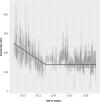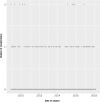Real-time assessment of learning curve for robot-assisted laparoscopic prostatectomy
- PMID: 32538121
- PMCID: PMC7591624
- DOI: 10.1308/rcsann.2020.0139
Real-time assessment of learning curve for robot-assisted laparoscopic prostatectomy
Abstract
Introduction: The learning curves analysed to date for robot-assisted laparoscopic prostatectomy are based on arbitrary cut-offs of the total cases.
Methods: We analysed a large dataset of robot-assisted laparoscopic prostatectomies from a single centre between 2008 and 2019 for assessment of the learning curve for perioperative outcomes with respect to time and individual cases.
Results: A total of 1,406 patients were evaluated, with mean operative time 198.08 minutes and mean console time 161.05 minutes. A plot of operative time and console time showed an initial decline followed by a near-constant phase. The inflection points were detected at 1,398 days (308th case) for operative time and 1,470 days (324th case) for console time, with a declining trend of 8.83 minutes and 7.07 minutes, respectively, per quarter-year (p<0.001). Mean estimated blood loss showed a 70.04% reduction between the start (214.76ml) and end (64.35ml) (p<0.001). The complication rate did not vary with respect to time (p=0.188) or the number of procedures (p=0.354). There was insufficient evidence to claim that the number of operations (p=0.326), D'Amico classification (p=0.114 for intermediate versus low; p=0.158 for high versus low) or time (p=0.114) was associated with the odds of positive surgical margins.
Conclusions: It takes about 300 cases and nearly 4 years to standardise operative and console times, with a requirement of around 80 cases per annum for a single surgical team in the initial years to optimise the outcomes of robot-assisted laparoscopic prostatectomy.
Keywords: Learning curve; Perioperative complications; Perioperative outcomes; Robot-assisted laparoscopic prostatectomy.
Figures
References
-
- Herrell SD, Smith JA Jr. Robotic-assisted laparoscopic prostatectomy: what is the learning curve?. Urology 2005; : 105–107. - PubMed
-
- Artibani W, Novara G. Cancer-related outcome and learning curve in retropubic radical prostatectomy: ‘if you need an operation, the most important step is to choose the right surgeon’. Eur Urol 2008; : 874–876. - PubMed
-
- Patel VR, Sivaraman A, Coelho RF et al. . Pentafecta: a new concept for reporting outcomes of robot-assisted laparoscopic radical prostatectomy. Eur Urol 2011; : 702–707. - PubMed
-
- Vickers AJ, Bianco FJ, Serio AM et al. . The surgical learning curve for prostate cancer control after radical prostatectomy. J Natl Cancer Inst 2007; : 1171–1177. - PubMed
MeSH terms
LinkOut - more resources
Full Text Sources





